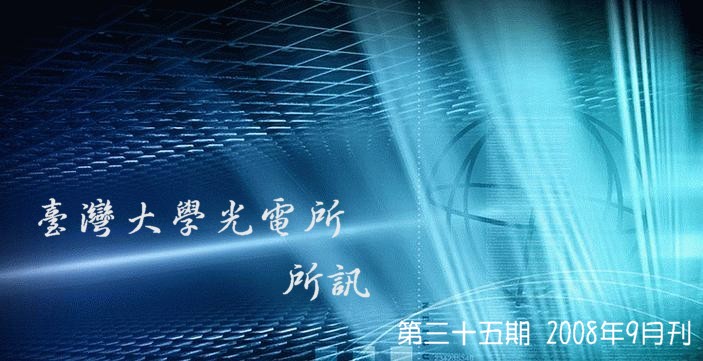 |
||||||||
|
|
||||||||
|
发行人:黄升龙所长 编辑委员:蔡睿哲教授 主编:林筱文 发行日期:2008.09.03 |
||||||||
|
|
||||||||
|
时间:2008年8月11日上午10点30分~11点45分
讲者:Prof.
Ray T. Chen (Nanophotonics and Optical Interconnects Lab., Department of
Electrical and Computer Engineering, The University of Texas, Austin) Prof. Ray T. Chen于2008年8月11日(星期一)莅临本所访问,并于电机二馆142会议室发表演说,讲题为「Silicon- and Polymer-based Nanophotonic Devices for Optical Communications」,本所教师及学生皆热烈参与演讲活动,获益良多。
时间:2008年8月25日下午3点
讲者:何赛灵教授(Joint
Research Center of Photonics of the Royal Institute of Technology
(Sweden) and Zhejiang University (China)) 何赛灵教授于2008年8月25日(星期一)莅临本所访问,并于电机二馆105演讲厅发表演说,讲题为「Improving the performances and functionalities of photonics devices with subwavelength-structures and nanoparticles」,本所教师及学生热烈参与演讲活动。
|
||||||||
Ferroelectric nitride-oxide nanowire MOSFET and phase change memory Professor Lung-Han Peng's group Graduate Institute of Photonics and Optoelectronics, National Taiwan University (e-mail) peng@cc.ee.ntu.edu.tw 台湾大学光电所彭隆瀚教授 A. Nitride-oxide nanowire MOSFET
We demonstrated a selective growth of high crystallinity
B. Nitride-oxide phase change memory We report a new type of phase-change materials based upon the compound of In-Ga-O. It is found to exhibit two-order of magnitude resistivity change between the high-resistive amorphous phase and the low-resistive cubic phase at a phase-change temperature ~250°C. When the In-Ga-O is incorporated into a nonvolatile phase change memory (PCM) device with a double-heater (DH) structure, it exhibits an on/off resistance ratio of 1000 and cycling over 300 times which are superior to those observed on a single-heater (SH) PCM device. These results, together with a low bias point of 70mA at 6.5 volt and 1.5mA at 3.5 volt, respectively, for set/ reset operation of the DH-PCM device to the crystalline/amorphous state, suggest that In-Ga-O is a promising material candidate for low power application of PCM devices.
|
||||||||
|
论文题目:活体内光学三倍频分子影像显微术 姓名:戴世芃 指导教授:孙启光教授
|
||||||||
|
— 数据提供:影像显示光电科技特色人才培育中心.影像显示科技知识平台 — — 整理:林晃岩教授、陈冠宇 —
南韩LG显示器针对OLED面板开发出了称为“DOD”(Dual-plate OLED Display)的新型面板结构,并于SID 2008口头报告3.2中发布。采用这一结构的15吋有机EL面板试制品,也在SID 2008展示会场上展出(如图一)。
具有DOD结构的有机EL面板由两块玻璃底板构成。在一块玻璃底板上形成薄膜晶体管(TFT),另一块玻璃底板上形成有机EL组件;并采用了TFT数组的阳极与有机EL组件的阴极在面板内部接触的结构(如图二)。该结构时的制作流程如图三所示。南韩LG显示器认为,由于能够分别单独地检查显示组件,因此与原来在一块玻璃底板上形成TFT数组和有机EL组件的有机EL面板相比,能够防止成品良率下降。
15吋有机EL面板的画素为1024×768画素。画素大小为96μm×297μm,分辨率为85.5ppi。画素开口率为52%。采用从有机EL组件的底板一侧获取光的顶部发光结构。
用一个表总结这个技术的优点。低温多晶硅薄膜晶体管(LTPS TFT)的下发光形式:因为下发光,所以开口率太小;因为低温多晶硅薄膜晶体管关系无法做大且亮度不均,只能用到第四代基板。低温多晶硅薄膜晶体管的上发光形式:无法做大;穿透电极为金属,会有能量损耗,减损出光效率。非晶硅薄膜晶体管(a-Si TFT)的上发光形式:可大至第八代基板,但一路做上来的良率不高。非晶硅薄膜晶体管的DOD形式:基板可做大,发光OLED与控制TFT分开来制作,可以提高良率。
中文新闻出处: http://big5.nikkeibp.co.jp/china/news/news/flat200805230125.html
|
||||||||
|
饭后来瓶清凉饮料超爽!然后…得肠癌 ? 有此一说 最近看到下列文章有点疑惑,请问是真的吗? 「不要不相信! 很多人习惯吃饱饭后就来一瓶冷饮,尤其是一些罐装茶饮料,号称可以「去油解腻」。喝下去是很爽没有错,但你有没有想过接下来你的肚子里会发生什么事?! 快动动大脑想想吧!你肚子里的牛排(或是咸酥鸡、卤味…)都是油腻腻的食物,肠胃要消化本来就比较吃力了。现在再倒入一瓶冰水…有没有看过冰箱里面的猪油牛油啊?!你能想象把上面那层白白的凝固油吞进肚子里吗?恶!当你的肠胃里有一块块蜡烛般的凝固油,还去什么油、解什么腻咧!如果只是恶心的话就算了,重点是—会得肠癌!!这些凝固油碰到胃酸会再度溶解成半液状,然后会比固态食物早一步流进肠道里。于是那稠稠黏黏、油不油水不水的物质就会率先被肠道吸收。但是,肠道并没有办法完全吸收排除这些诡异的物质,肠璧绒毛会沾满油脂,就好像冬天要洗牛肉汤的锅子一样,怎么洗都还是觉得油腻腻。而且久而久之这种恶心的东西就会附着在肠道壁上—你总不能往肠子里倒色拉脱吧?!经过经年累月的堆积和质变,这些东西轻则导致息肉,更有可能的是病变成肠癌! 所以赶快改掉这种要命的坏习惯!饭后不要马上灌冷饮,最好是喝点热汤或温开水就好啦!然后平常没事多喝酸奶。酸奶可以让肠道里多点好菌、赶走坏菌,帮你的肠子来个大扫除,让肠道更干净~ 」
KingNet
营养保健咨询营养师回答: 关于上述文章(传言)的内容,在下认为其「作者」用心良苦,但太过于「危言耸听」! 饭后立即饮用冷饮的确有碍身体健康。由于人类是恒温的动物,中心体温平均为37.5℃,所以过度地食用冰冷的饮品,就很容易造成生理机能减退。例如:肠胃道消化酵素分泌减少,进而造成肠胃消化吸收功能变差,不想吃饭,体重减轻,抵抗力也跟着变弱。这也就是为什么饭后喝冷饮较被人诟病的原因。
至于,喝冷饮会将猪油、牛油变成固体或半固体的异形物的说法就真的太夸张了!虽说冷饮会影响体温,但却只是暂时性的,毕竟人类是恒温动物,身体有许多生理构造及方法可以立即调整体内温差,使得生理机能能尽快恢复正常的功能,包括肠胃道里的酵素机能—脂解酵素(脂肪分解酵素),它是主要分解脂肪的酵素,经由它的帮忙,肠黏膜组织才能顺利吸收乳糜微粒。换言之,脂肪在被肠子吸收前,就已经被脂解酵素「处理」过了!并不像上述传言说的:「肠道并没有办法完全吸收排除这些诡异的物质,肠璧绒毛会沾满油脂。就好像冬天要洗牛肉汤的锅子一样,怎么洗都还是觉得油腻腻。」;其实,别太小看人体生理的构造,但也别太过于「折磨」你的生理器官。一旦身体在被你反复地「折磨」及「激烈调节」之下,(例如:喜欢冷热食物交换食用)一旦身体突然地无法负荷,那么就有可能让病菌有机可乘,甚至导致任何疾病上身,故不得不小心谨慎。好的饮食习惯,才是最佳的养生之道。 本文由【KingNet 国家网络医院】提供
|
||||||||
|
版权所有 国立台湾大学电机信息学院光电工程学研究所 http://gipo.ntu.edu.tw/ 欢迎转载 但请注明出处 http://gipo.ntu.edu.tw/monthly.htm |
||||||||